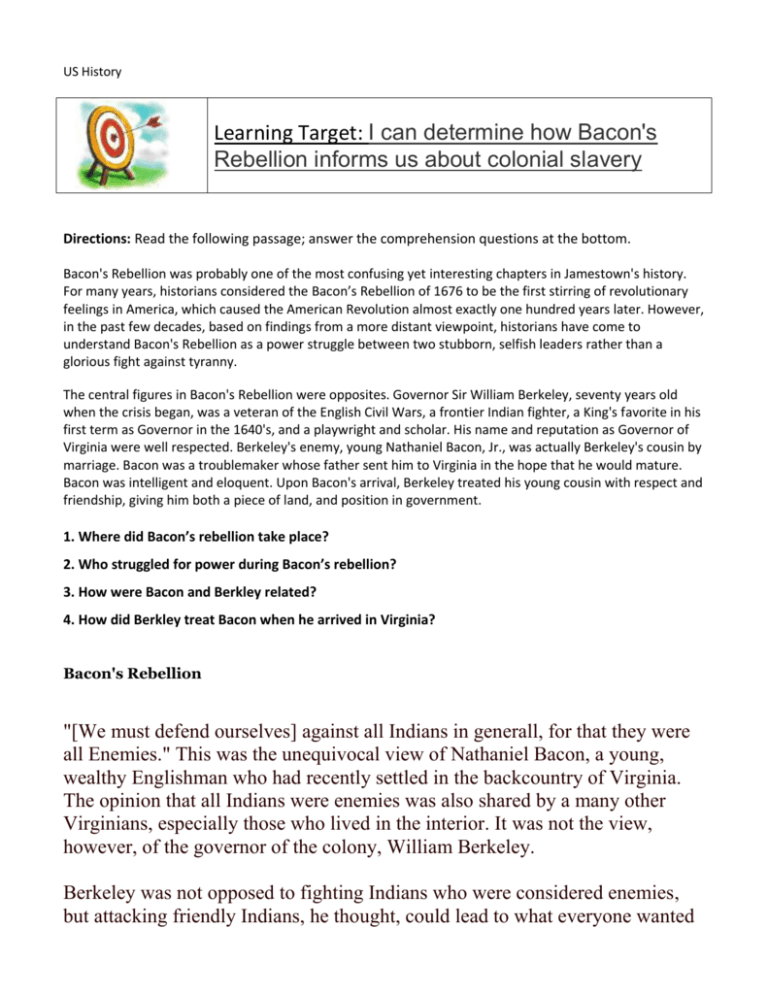Learning Target: I can determine how Bacon`s Rebellion informs us
advertisement

US History Learning Target: I can determine how Bacon's Rebellion informs us about colonial slavery Directions: Read the following passage; answer the comprehension questions at the bottom. Bacon's Rebellion was probably one of the most confusing yet interesting chapters in Jamestown's history. For many years, historians considered the Bacon’s Rebellion of 1676 to be the first stirring of revolutionary feelings in America, which caused the American Revolution almost exactly one hundred years later. However, in the past few decades, based on findings from a more distant viewpoint, historians have come to understand Bacon's Rebellion as a power struggle between two stubborn, selfish leaders rather than a glorious fight against tyranny. The central figures in Bacon's Rebellion were opposites. Governor Sir William Berkeley, seventy years old when the crisis began, was a veteran of the English Civil Wars, a frontier Indian fighter, a King's favorite in his first term as Governor in the 1640's, and a playwright and scholar. His name and reputation as Governor of Virginia were well respected. Berkeley's enemy, young Nathaniel Bacon, Jr., was actually Berkeley's cousin by marriage. Bacon was a troublemaker whose father sent him to Virginia in the hope that he would mature. Bacon was intelligent and eloquent. Upon Bacon's arrival, Berkeley treated his young cousin with respect and friendship, giving him both a piece of land, and position in government. 1. Where did Bacon’s rebellion take place? 2. Who struggled for power during Bacon’s rebellion? 3. How were Bacon and Berkley related? 4. How did Berkley treat Bacon when he arrived in Virginia? Bacon's Rebellion "[We must defend ourselves] against all Indians in generall, for that they were all Enemies." This was the unequivocal view of Nathaniel Bacon, a young, wealthy Englishman who had recently settled in the backcountry of Virginia. The opinion that all Indians were enemies was also shared by a many other Virginians, especially those who lived in the interior. It was not the view, however, of the governor of the colony, William Berkeley. Berkeley was not opposed to fighting Indians who were considered enemies, but attacking friendly Indians, he thought, could lead to what everyone wanted to avoid: a war with "all the Indians against us." Berkeley also didn't trust Bacon's intentions, believing that the upstart's true aim was to stir up trouble among settlers, who were already discontent with the colony's government. Bacon attracted a large following who, like him, wanted to kill or drive out every Indian in Virginia. In 1675, when Berkeley denied Bacon a commission (the authority to lead soldiers), Bacon took it upon himself to lead his followers in a crusade against the "enemy." They marched to a fort held by a friendly tribe, the Occaneechees, and convinced them to capture warriors from an unfriendly tribe. The Occaneechees returned with captives. Bacon's men killed the captives They then turned to their "allies" and opened fire. Berkeley declared Bacon a rebel and charged him with treason. Just to be safe, the next time Bacon returned to Jamestown, he brought along fifty armed men. Bacon was still arrested, but Berkeley pardoned him instead of sentencing him to death, the usual punishment for treason. Still without the commission he felt he deserved, Bacon returned to Jamestown later the same month, but this time accompanied by five hundred men. Berkeley was forced to give Bacon the commision, only to later declare that it was void. Bacon, in the meantime, had continued his fight against Indians. When he learned of the Govenor's declaration, he headed back to Jamestown. The governor immediately fled, along with a few of his supporters, to Virginia's eastern shore. Each leader tried to muster support. Each promised freedom to slaves and servants who would join their cause. But Bacon's following was much greater than Berkeley's. In September of 1676, Bacon and his men set Jamestown on fire. The rebellion ended after British authorities sent a royal force to assist in quelling the uprising and arresting scores of committed rebels, white and black. When Bacon suddenly died in October, probably of dysentery, Bacon's Rebellion fizzled out. Mini-Discussion What did the events of Bacon’s Rebellion say about who had greater or lesser rights and power in colonial America? Exit Ticket What does Bacon’ Rebellion tell us about colonial slavery? ______________________________________________________________________________________________________ ______________________________________________________________________________________________________ ______________________________________________________________________________________________________ ______________________________________________________________________________________________________ ______________________________________________________________________________________________________ ______________________________________________________________________________________________________ ______________________________________________________________________________________________________ ______________________________________________________________________________________________________ ______________________________________________________________________________________________________ ______________________________________________________________________________________________________ ______________________________________________________________________________________________________ ______________________________________________________________________________________________________ ______________________________________________________________________________________________________ ______________________________________________________________________________________________________ ______________________________________________________________________________________________________ 0 Insufficient Assertion Context Does not address the question, does not reference the text, or is totally inaccurate. Evidence Assertion is invalid Misunderstanding of the text or question. Not included Some text-based evidence to support assertion. Some… Irrelevant or insufficient Too general or simple Assumed evidence An attempt to explain the evidence Implausible May not link evidence to the assertion Interpretation Grammar and Spelling 1 Developing Unintelligible or indecipherable Grammar and spelling minimally hinder readability. 2 Proficient 3 Advanced Valid inference and/or assertion based on the text and question. Demonstrates advanced thinking. Attempts to include background information to introduce evidence Sufficient, relevant textual evidence to develop assertion Includes relevant background information to introduce evidence N/A Valid interpretation of the evidence that explains the evidence and links evidence to the assertion Exemplary interpretation of the evidence; demonstrates advanced thinking Overwhelmingly correct use of grammar and spelling allow for smooth reading. Perfectly correct use of grammar and spelling. KEY Directions: Read the following passage; answer the comprehension questions at the bottom. Bacon's Rebellion was probably one of the most confusing yet interesting chapters in Jamestown's history. For many years, historians considered the Bacon’s Rebellion of 1676 to be the first stirring of revolutionary feelings in America, which caused the American Revolution almost exactly one hundred years later. However, in the past few decades, based on findings from a more distant viewpoint, historians have come to understand Bacon's Rebellion as a power struggle between two stubborn, selfish leaders rather than a glorious fight against tyranny. The central figures in Bacon's Rebellion were opposites. Governor Sir William Berkeley, seventy years old when the crisis began, was a veteran of the English Civil Wars, a frontier Indian fighter, a King's favorite in his first term as Governor in the 1640's, and a playwright and scholar. His name and reputation as Governor of Virginia were well respected. Berkeley's enemy, young Nathaniel Bacon, Jr., was actually Berkeley's cousin by marriage. Bacon was a troublemaker whose father sent him to Virginia in the hope that he would mature. Bacon was intelligent and eloquent. Upon Bacon's arrival, Berkeley treated his young cousin with respect and friendship, giving him both a piece of land, and position in government. 1. Where did Bacon’s rebellion take place? _____________________________________________________________________________________ 2. Who struggled for power during Bacon’s rebellion? _____________________________________________________________________________________ _____________________________________________________________________________________ _____________________________________________________________________________________ 3. How were Bacon and Berkley related? _____________________________________________________________________________________ _____________________________________________________________________________________ _____________________________________________________________________________________ 4. How did Berkley treat Bacon when he arrived in Virginia? _____________________________________________________________________________________ _____________________________________________________________________________________ _____________________________________________________________________________________ Bacon's Rebellion Mini-Discussion What did the events of Bacon’s Rebellion say about who had greater or lesser rights and power in colonial America? Exit Ticket 1.23 How the events of Bacon's Rebellion reflected who had greater or lesser rights and power in colonial America. ______________________________________________________________________________________________________ ______________________________________________________________________________________________________ ______________________________________________________________________________________________________ ______________________________________________________________________________________________________ ______________________________________________________________________________________________________ ______________________________________________________________________________________________________ ______________________________________________________________________________________________________ ______________________________________________________________________________________________________ ______________________________________________________________________________________________________ ______________________________________________________________________________________________________ ______________________________________________________________________________________________________ ______________________________________________________________________________________________________ ______________________________________________________________________________________________________ ______________________________________________________________________________________________________ ______________________________________________________________________________________________________ 0 Insufficient Assertion Context Does not address the question, does not reference the text, or is totally inaccurate. Evidence Assertion is invalid Misunderstanding of the text or question. Not included Some text-based evidence to support assertion. Some… Irrelevant or insufficient Too general or simple Assumed evidence An attempt to explain the evidence Implausible May not link evidence to the assertion Interpretation Grammar and Spelling 1 Developing Unintelligible or indecipherable Grammar and spelling minimally hinder readability. 2 Proficient 3 Advanced Valid inference and/or assertion based on the text and question. Demonstrates advanced thinking. Attempts to include background information to introduce evidence Sufficient, relevant textual evidence to develop assertion Includes relevant background information to introduce evidence N/A Valid interpretation of the evidence that explains the evidence and links evidence to the assertion Exemplary interpretation of the evidence; demonstrates advanced thinking Overwhelmingly correct use of grammar and spelling allow for smooth reading. Perfectly correct use of grammar and spelling.








